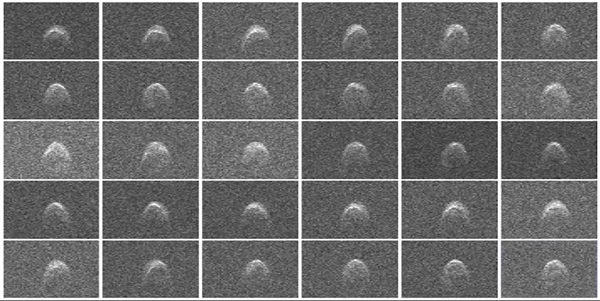The asteroid is between 660 and 980 feet (200 and 300 meters) in diameter; it has a rounded and slightly asymmetric shape. As it rotates, a number of features are evident that suggest the presence of some flat regions and a bulge near the equator.
The data were obtained between 3:40 and 10:10 a.m. EDT. At the time of the observations, the asteroid’s distance was about 1.93 million miles (3.1 million kilometers) from Earth, which is 8.2 lunar distances away. The data were obtained over an interval of 6.5 hours as the asteroid completed about 2.4 rotations. The resolution is 12 feet (3.75 meters) per pixel.
Radar is a powerful technique for studying an asteroid’s size, shape, rotation state, surface features and surface roughness, and for improving the calculation of asteroid orbits. Radar measurements of asteroid distances and velocities often enable computation of asteroid orbits much further into the future than if radar observations weren’t available.
NASA places a high priority on tracking asteroids and protecting our home planet from them. In fact, the United States has the most robust and productive survey and detection program for discovering near-Earth objects. To date, U.S. assets have discovered more than 98 percent of the known near-Earth objects.
In addition to the resources NASA puts into understanding asteroids, it also partners with other U.S. government agencies, university-based astronomers, and space science institutes across the country that are working to track and understand these objects better, often with grants, interagency transfers, and other contracts from NASA.
In 2016, NASA will launch a robotic probe to one of the most potentially hazardous of the known near-Earth objects. The OSIRIS-REx mission to asteroid (101955) Bennu will be a pathfinder for future spacecraft designed to perform reconnaissance on any newly discovered threatening objects. Aside from monitoring potential threats, the study of asteroids and comets enables a valuable opportunity to learn more about the origins of our solar system, the source of water on Earth, and even the origin of organic molecules that led to the development of life.
NASA recently announced development of a first-ever mission to identify, capture, and relocate an asteroid for human exploration. Using game-changing technologies, this mission would mark an unprecedented technological achievement that raises the bar of what humans can do in space.










